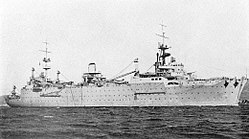Commandant test
|
||||||||||||||||
|
||||||||||||||||
|
||||||||||||||||
|
||||||||||||||||
The Commandant Teste was an aircraft mothership in the French Navy before and during World War II . It was named after the pioneer of the French naval aviation Paul Teste († 1925), who was the first Frenchman to land on a ship's deck on October 20, 1920.
The ship had an eventful career: it was involved in the British attack on the French fleet in Mers-el-Kébir ( Operation Catapult ) on July 3, 1940 and in the self-sinking of the Vichy fleet in Toulon on November 27, 1942. It was sunk twice and raised twice.
Technical specifications
After the aircraft carrier Béarn was put into service in 1926, the French naval command wanted a second floating aircraft base, but opted for a faster and cheaper to build aircraft mother ship. The Commandant Teste was in May 1927 at the shipyard "Chantier F et C de la Gironde" in Bordeaux to put Kiel , ran on 12 April 1929 by stack and was put into service the 1,932th At 167 m long, 27 m wide and 7.40 m draft , she displaced 11,500 tons fully equipped. Two Schneider - Zoelly turbines with a total of 21,000 HPw (15,500 kW) gave it a top speed of 20.5 knots. The radius of action was 8,500 nautical miles. The armament consisted of twelve 100 mm and eight 37 mm anti-aircraft guns and twelve machine guns . The crew numbered 686 men.
The ship was equipped with four catapults and five cranes with a lifting force of 12 tons each. The hangar with a size of 84 m × 27 m × 7 m allowed to accommodate up to 26 seaplanes . These could be torpedo planes , bombers or reconnaissance planes . In fact, the Commandant Teste was equipped with the following types of aircraft, among others:
career
The Commandant Teste served in the Mediterranean and took part in the neutrality patrols off the Spanish coast during the Spanish Civil War. After the outbreak of World War II, she gave up her seaplanes and served as an aircraft transporter between the French possessions in North Africa and the mother country.
On July 3, 1940, she was in Mers-el-Kébir when the British Force H under Vice Admiral Somerville attacked the French naval units lying there, sank the battleship Bretagne and damaged the other ships lying at the mole or at anchor. The only major French ship that survived the attack with virtually no damage was the Commandant Teste . The ship escaped from the mined port during the night of July 4th and ran via Arzew first to Biserta and then to Toulon . It was sighted by the British submarine Proteus , but it found no opportunity to attack.
The Commandant Teste was in Toulon on November 27, 1942, when Admiral Jean de Laborde , commander of the Vichy regime's deep-sea fleet, ordered the fleet to sink itself after the German Wehrmacht invaded the previously unoccupied zone of Vichy France ( Company Anton ), so as not to let them fall into German hands. Like almost the entire fleet, the Commandant Teste was sunk. It was lifted by the Italian Navy on May 1, 1943, taken by the German Navy in September 1943 , but then on the night of 18/19. Sunk again by Allied bombers in August 1944 .
The End
In February 1945 she was lifted again because she was thought to be repairable and wanted to be used as a training ship. This turned out to be impracticable, and she instead served as a storage ship for US-supplied military equipment until 1950. On May 15, 1950 she was removed from the list of naval vessels and finally sold for scrapping in 1963.
literature
- Francis Dousset: Les porte-avions français des origines 1911 à nos jours. Éditions de la Cité, Brest 1978, ISBN 2-85186-015-1 (French)
- John Jordan: The aircraft transport Commandant Teste. In: Warship 2002-2003. Conway's Maritime Press, ISBN 0-85177-926-3 (English)
